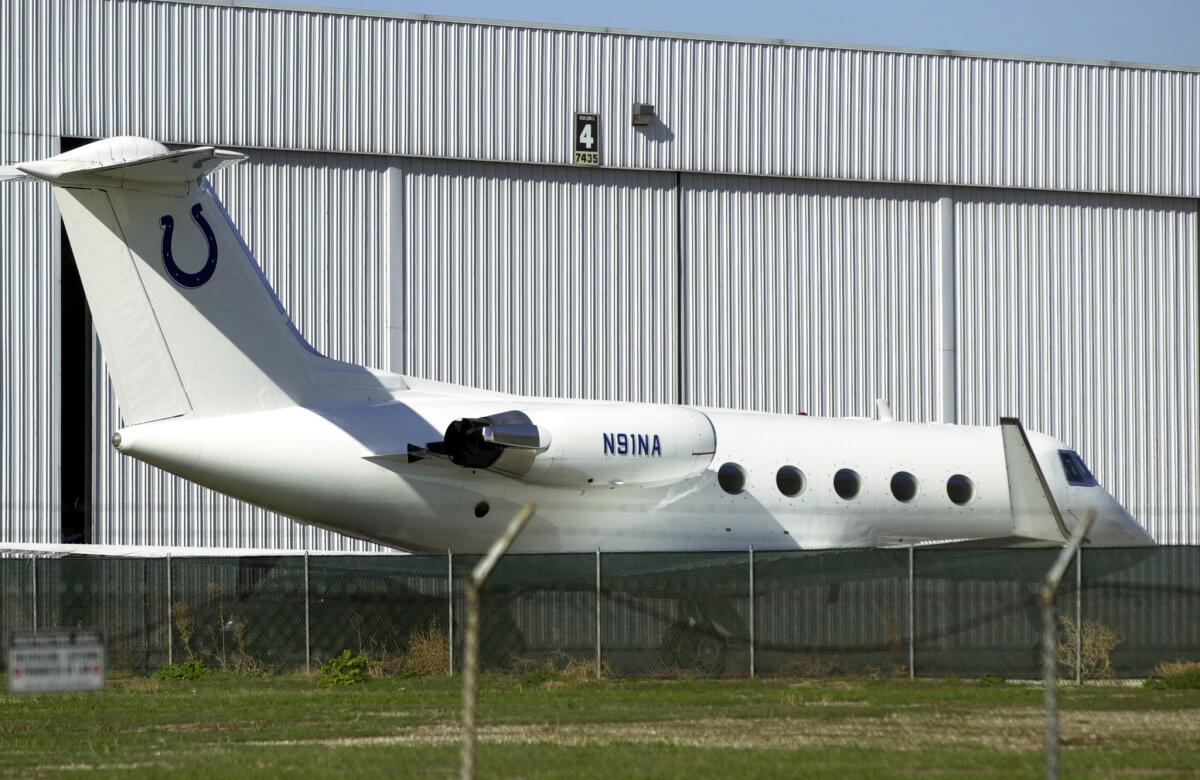NFL teams often use L.A. to get better deals to stay where they are

The scene was unremarkable: a white Gulfstream parked alongside a chain-link fence at Van Nuys Airport. The most conspicuous part of the plane was the large blue horseshoe near the top of the tail â the signature logo of the Indianapolis Colts.
It came off as a thinly veiled message â not to the people of Los Angeles, but to those back in Indiana worried their NFL team might leave. The Colts were looking to squeeze their city for a better deal.
Three years later, in 2005, the Colts broke ground on $720-million Lucas Oil Stadium in downtown Indianapolis, with the team paying $100 million and the city and state kicking in the rest.
L.A. had again been jilted by another in a long line of would-be suitors. L.A. has been more valuable to the NFL without a team than with one, and owners have used the threat of moving here to improve aging stadiums and bolster bottom lines.
Thatâs why the news this week the St. Louis Rams owner plans to build a stadium in Inglewood had a familiar ring to it.
More than half of the NFLâs 32 teams have used moving to L.A. as leverage since the Raiders and Rams pulled up stakes, playing their last games here on Christmas Eve 1994. Some stirred the pot by floating rumors they were flirting with L.A., while others gave serious consideration to the prospect.
âItâs like the rabbit at the dog track. L.A.âs always chasing the rabbit, and the NFL has also used L.A. as the rabbit,â said Fred Rosen, the former chairman of the âFootball L.A.â task force created by then-L.A. Mayor Richard Riordan after the Raiders and Rams left.
The tactic works. Since the last pro game here, 27 NFL stadiums have been built or undergone at least $400 million in renovations.
âThereâs no question thatâs part of the game,â said R.D. Hubbard, who in the mid-1990s fronted an effort to build an NFL stadium at Hollywood Park.
Rams owner Stan Kroenke hasnât promised to bring his team, but his stadium plan marks the boldest step toward an NFL return since February of 1996, when the Seattle Seahawks made a short, ill-fated journey down Interstate 5.
For one week, the Seahawks held off-season workouts at Rams Park, the old elementary school in Anaheim abandoned by the Rams when they departed for St. Louis a year earlier.
Ken Behring, then the owner of the Seahawks, wanted a new stadium but comically cited earthquake concerns as part of his decision to leave Seattle for Southern California. The NFL threatened a fine of $500,000 per week if the franchise didnât return. Soon, the moving trucks were on a return trip up the 5.
The Seahawks eventually got their new, state-of-the-art home field.
Kroenkeâs bid is different from past proposals: it is the first time an NFL owner, parcel of land and stadium plan have come together in the same package. Even longtime observers of the areaâs quest for a team find promise in the effort, with Hubbard saying itâs âprobably for real.â
âThe question really becomes: Los Angeles is the second-largest market in the country and can the NFL afford to continue to use it as a stalking horse?â said Bob Graziano, the former Dodgers president who in the 1990s worked on the concept of an NFL stadium at Chavez Ravine. âOr at some point in time does it make much more economic sense to actually put a team here?â
The strategy of using a city as leverage isnât new. Floridaâs Tampa-St. Petersburg area filled the role for years in Major League Baseball, until 1998 when the expansion Rays arrived. After the NBAâs Seattle SuperSonics moved to Oklahoma City in 2008, Seattle became a go-to spot for teams interested in better deals from their cities. Las Vegas is mentioned as an NHL possibility.
In the NFL, the Buffalo Bills were courted by Toronto, and the Oakland Raiders touted a meeting with San Antonio officials. London also perpetually surfaces in discussions about future sites for NFL teams.
Reminders of the false starts in L.A. linger. The NFL has returned to each market that has lost a team in the leagueâs modern era â but not to L.A., despite two decades of pledges and plans.
In 2003, for instance, the San Diego Chargers moved their training camp to Carson for the summer. That fueled speculation about the franchise preparing for a full-time move north. Two years later, the Chargers returned to their facility in San Diego.
Cozying up with L.A. hasnât always led to improved stadiums. The Chargers and Raiders, two of the most frequently discussed candidates to relocate, still occupy stadiums regarded as two of the NFLâs worst.
Even without a franchise or two in L.A., the NFL reigns as the countryâs most popular â and profitable â sport. The league pulls in more than $9 billion in annual revenue. Even a slew of off-field problems this season didnât damage television ratings.
âWhatâs happened over the last 20 years is that the NFL hasnât taken a hit by not having a team in Los Angeles,â said former Fox Sports President Ed Goren, noting league franchise values have increased tenfold during that span and the leagueâs television contracts routinely break records.
âYou always want one guy on the outside and you use him. Itâs just good business.â
Follow Nathan Fenno on Twitter @NathanFenno
Follow Sam Farmer on Twitter @LATimesFarmer
More to Read
Go beyond the scoreboard
Get the latest on L.A.'s teams in the daily Sports Report newsletter.
You may occasionally receive promotional content from the Los Angeles Times.












